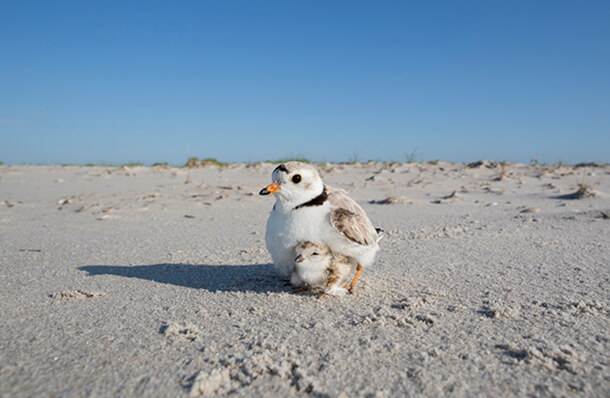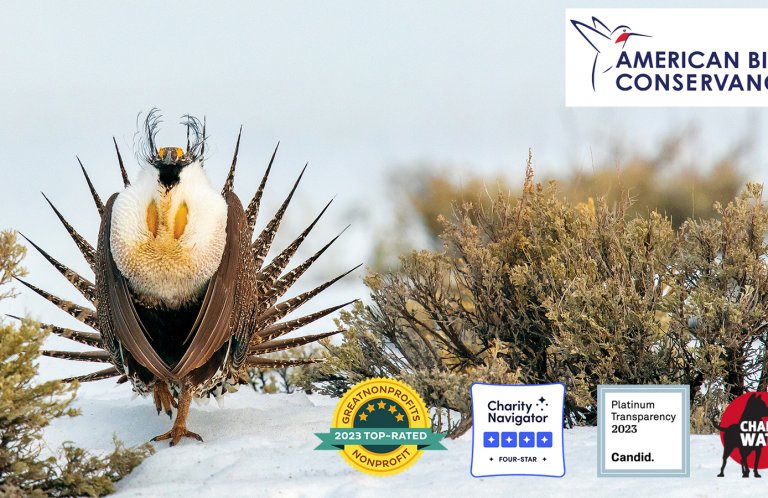Celebrating Birds and Their Habitats Conserved in 2023: Preventing Extinctions
Glittering Starfrontlet. Golden-winged Warbler. Either species would be enough to spark joy in a bird lover – and both of these priority species benefited from American Bird Conservancy's (ABC) work in 2023. But behind every bird we love is the habitat that sustains that species, and that's where we focus our efforts.
This year, working with dozens of partners across the Americas, we conserved thousands of acres of habitat for hundreds of bird species. As proud as we are to report below on some of these measurable conservation successes, we're just as proud of how the work gets done: We maintain an indivisible commitment to our principles, including operating with respect and integrity. And, we're steadfast in our mission – guided by the bird conservation framework that steers us toward four key outcomes year after year: preventing bird extinctions, reversing bird population declines, reducing threats to all birds, and building the bird conservation movement. Here are a few highlights of our work in 2023.
Preventing Bird Extinctions – Latin America & the Caribbean (and Beyond)
Since our founding in 1994, ABC has supported protection of more than 1.1 million acres in reserves that help reduce the risk of extinction for many of the Americas' most endangered birds. No fewer than 59 partner organizations have been instrumental in this accomplishment, spread across 15 countries, mostly in Latin America and the Caribbean, at 119 sites. To help these and other key places support thriving bird populations, we have also supported the planting of nearly 7.5 million trees and shrubs in reserves and buffer areas.
This year, 2023, our financial and technical support to partners resulted in protection of over 30,000 acres for endangered birds, ranging from Chile – where we worked with Chilean nonprofit ROC to protect 539 acres for the Peruvian Tern – to Colombia, where we supported Fundación Bioconservancy in securing over 1,700 acres for the Glittering Starfrontlet.
Seven thousand acres were acquired to support recovery of Colombia's Critically Endangered Gorgeted Puffleg, working with Fundación EcoHabitats; the land is now under conservation agreements with local communities in the western Andes. Other rare Colombian species also benefited from newly protected habitat, including the Antioquia Brushfinch, Black-and-Chestnut Eagle, Cundinamarca Antpitta, and Upper Magdalena Tapaculo. Additional priority species gaining habitat protection this year are the Cherry-throated Tanager and Kaempfer's Woodpecker (Brazil); Great Green Macaw (Costa Rica); Banded Ground-Cuckoo, Blue-throated Hillstar, El Oro Parakeet, and Purple Quail-Dove (Ecuador). (Read more about some of these successes here.)
New hope emerged this year for the Critically Endangered Blue-eyed Ground-Dove, a Brazilian endemic that numbers only about 16 wild individuals. Nesting success in the wild is low due to predation, but in 2023, conservationists successfully hand-raised two dove chicks, a sign that captive breeding is possible and can help boost the bird's population. Several partner organizations, including SAVE Brasil, the Latin American Reserve Stewardship Initiative (a program of ABC and March Conservation Fund), and the Toledo Zoo are involved in the project.
In Hawai'i, where 12 species of endangered forest birds must be saved from extinction, ABC and partners took a major step forward in our urgent Birds, Not Mosquitoes effort to combat deadly, mosquito-borne avian malaria. Helicopters delivered the first groups of male mosquitoes, containing a naturally occurring bacteria incompatible with wild mosquitoes, on Maui and Kaua‘i. Females mating with the incompatible males will produce infertile eggs — ultimately reducing mosquito populations and curbing transmission of avian malaria to birds like the Kiwikiu and ‘Akeke‘e.
Also in Hawai‘i, we're pleased to report that the Millerbird – a small songbird found only on two islands – is no longer on the brink of extinction. This welcome news was reflected in the 2023 decision by the International Union for Conservation of Nature to downlist the conservation status of the Millerbird from Critically Endangered to Endangered. The move comes a dozen years after the U.S. Fish and Wildlife Service, ABC, and other partners translocated 50 Millerbirds from Nihoa to Laysan (Kauō), two islands in the Northwestern Hawaiian Islands. Until the early 20th century, Laysan was home to a population of Millerbirds that went extinct due to invasive mammals. Today, the 50 translocated birds have become several hundred and expanded into all the vegetated parts of Laysan.
Across the Americas, seabirds are disappearing due to threats, including climate change, in vital places where they breed and feed. ABC is taking action on Molokai, Hawai‘i, where a predator-proof fence is nearing completion at an elevation well above projected sea-level rise. The enclosure, restored with native plants, will provide habitat for an entire community of seabirds: Wedge-tailed Shearwaters are already returning to breed, and we hope to attract many others, including Laysan Albatrosses — a species that's expected to lose much of its current low-lying habitat. In the Galapagos highlands, ABC's “Galapagos Petrels on Private Lands” program continues to extend its reach onto new private farms and is now working with 33 farms to preserve key habitat for this Critically Endangered species through mixed-use conservation and community engagement.
The Search for Lost Birds, a collaboration of ABC, BirdLife International, and Re:wild, defied the odds and rediscovered the Dusky Tetraka in Madagascar in 2022 and 2023. This small, olive-colored and yellow-throated bird had eluded ornithologists for 24 years. The expedition team, led by The Peregrine Fund's Madagascar Program, found the species in two different remote sites: one on the Masoala Peninsula in late December 2022 and another near Andapa in January this year. Now that this lost bird has been found, conservation plans can now be advanced to help ensure its survival.
ABC also supported and led an expedition to the island of Makira in the eastern Solomon Islands to look for the Critically Endangered Makira Moorhen, a bird not recorded since 1929. Despite an extensive search of areas never before surveyed by ornithologists, the team did not relocate the moorhen. But, due to the project's outreach and awareness campaigns, it helped to spur the development of the community-led Yato Protected Area. When designated, Yato will be the second-ever protected area in the Solomon Islands and the largest by an order of magnitude. It also will secure vital habitat for all of the island's 13 endemic bird species.
###
American Bird Conservancy (ABC) takes bold action to conserve wild birds and their habitats throughout the Americas. Inspired by the wonder of birds, we achieve lasting results for the bird species most in need while also benefiting human communities, biodiversity, and the planet's fragile climate. Our every action is underpinned by science, strengthened by partnerships, and rooted in the belief that diverse perspectives yield stronger results. Founded as a nonprofit organization in 1994, ABC remains committed to safeguarding birds for generations to come. Join us! Together, we can do more to ensure birds thrive.
Media Contact
Jordan Rutter
Director of Communications
media@abcbirds.org


















































